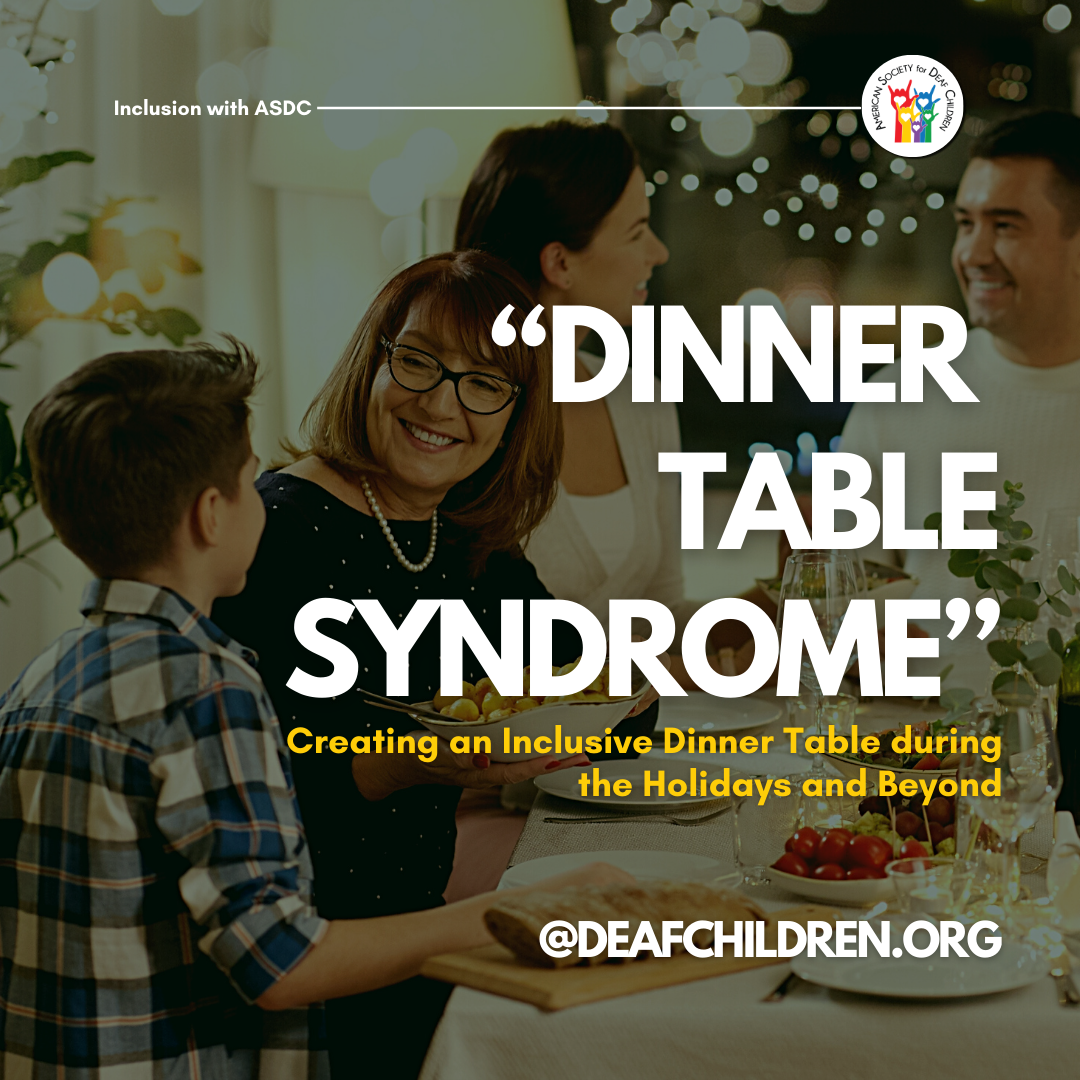
In our wonderfully diverse world, there’s something truly special about gathering around the dinner table with our loved ones. It’s where we share delicious meals and laughter and make memories that last a lifetime. But for our Deaf and Hard-of-Hearing kids, it can sometimes feel lonely, isolating, and like they’re the only ones facing unique challenges at the table.
That’s where ‘Dinner Table Syndrome’ comes in. It’s all about finding ways to make everyone feel welcome and embracing the beautiful differences that make our gatherings even more special.
Fostering Inclusivity at the Dinner Table:
Understanding ‘Dinner Table Syndrome’
Are you familiar with “Dinner Table Syndrome”? This very real lived experience affects Deaf and Hard-of-Hearing (D/HH) individuals, both adults and children. It’s a term used to describe the isolation they often feel when surrounded by hearing people, whether non-signing or signing, leading to exclusion from conversations and interactions at the dinner table.
Imagine being a child in this situation, where full mouths, simultaneous conversations, abrupt topic changes, and poor lighting combine to create communication challenges. You’d likely experience emotions such as hurt, upset, exclusion, and isolation. This situation often leads to feelings of stress, loneliness, frustration, anger, and a sense of being unimportant. Surprisingly, your fellow diners might perceive you as rude for not participating fully. They may not understand why you’ve become withdrawn and quiet.
Many stories of holiday gatherings “gone wrong” resonate with those in the D/HH community who often feel isolated and outcast when they go home for the holidays. It’s an experience that is far too common for many D/HH individuals during family and friends outings, birthday parties, work or school events, and festive gatherings.
“More than 90% of deaf or hard-of-hearing children are born to hearing parents, like us,” states ASDC Executive Director Cheri Dowling. “Without other deaf or hard-of-hearing relatives or individuals around or to learn from, the communication barriers can be significant.”
But these barriers don’t have to be insurmountable. If you have a D/HH family member or will be hosting a D/HH guest, ASDC has resources to help you ensure they feel accepted and included this holiday season or any friend or family gathering.
Here are some tips to help you better understand the situation and become more D/HH-aware, particularly when it comes to children and young adults:
Involve them: Many hearing people may ignore a D/HH child or young adult because they’re unsure how to communicate with them. Use visual cues or gently tap the D/HH individual to get their attention and interact with them directly. Use gestures and facial expressions to convey meaning. D/HH children especially appreciate it when family members ask more questions beyond superficial small talk or try to include them in jokes and funny stories.
Educate yourself: Take a beginning ASL Class or use a Fingerspelling App – ASDC has an award-winning ASL Fingerspelling App on our website that will support you in learning a few basic signs. And don’t worry if you are still learning to sign — your enthusiasm will be contagious!
Eyeball the environment: D/HH people rely on what they see to understand conversation and other contexts. Ensure the space for your gathering is well-lit and does not have a lot of visual barriers. This will not only foster communication but also reduce eye strain. Removing large centerpieces or table decorations that obstruct the view can benefit everyone.
Turn on the captions: Be mindful if you’re watching the big game or a holiday parade as part of your celebrations to include D/HH guests. Avoid awkwardly fumbling through your television’s settings during your show by turning on closed captioning before your guests arrive. Captions help D/HH people follow what is happening on television, especially in a noisy or busy environment, such as a large family gathering. As a bonus, they can also benefit your hearing guests.
Hire a professional: Hire an interpreter or use a qualified speech-to-text service, making sure to involve the D/HH child or young adult in the choice. Each D/HH person has their strengths and preferences. If cost is an issue, research pro-bono services or an ASL interpreter program in your area. Consider splitting the cost with other guests.
Use what you have: If professional services are not feasible, look for other options, such as downloading a phone app that transcribes speech. Have a notepad, pen, or small whiteboard to write questions or requests. Most iPhones have a speech-to-text feature that can be beneficial.
Play D/HH-friendly games: Avoid activities heavily dependent on oral cues and opt for games that rely more on visual cues or physical competition.
Check-in and ask questions: Reach out to the D/HH individual directly and ask questions like, “How do you prefer to communicate?” or “What can I do differently to communicate better?” or “Have you felt isolated before? How can we change that for you?”
Mind your speaking habits: Refrain from speaking with your mouth full or turning away from the D/HH individual. Avoid covering your mouth with your hand when speaking, as this impedes lip-reading.
Get their attention: Before sharing a story, attract the D/HH individual’s attention by waving in their eyeline or tapping their shoulder. Ensure they understand the conversation and that you genuinely want to include them.
Don’t exclude them: If the D/HH individual misses part of the conversation, don’t leave them out or dismiss it with phrases like “it was nothing” or “I’ll tell you later.” This deprives them of the opportunity to participate in the moment.
Spread awareness: Help ASDC raise awareness by sharing these straightforward tips to ensure everyone feels more included, especially D/HH children and young adults.
Following these straightforward steps ensures that everyone, especially D/HH children and young adults, is embraced and included at the dinner table, creating a warm and welcoming atmosphere for all to enjoy this holiday season and beyond. It’s about bridging gaps and fostering a sense of belonging so that no one feels left out.
Join us in creating inclusivity, one home, and community at a time.
______________________
You can learn more about promoting inclusivity and supporting D/HH children and young adults by visiting our website. Explore resources, educational tools, and valuable insights to make a difference in the lives of our D/HH kids.
Do you have helpful tips in addition to these that foster inclusion at your dinner table? We’d love to hear from you! Please share by sending your tips to us at info@deafchildren.org



